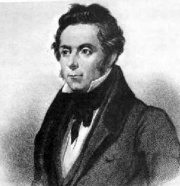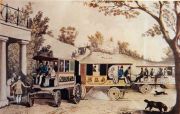Walter Hancock (1799-1852) of High Road, Stratford, Essex was a builder of steam powered road vehicles.
See also
- Walter Hancock: Narrative of Twelve Years Experiments, 1824-36
- Walter Hancock by William Fletcher
- Walter Hancock: List of Vehicles
- Walter Hancock: DNB entry
- Walter Hancock: Stoomwagens op Gewone Wegen 1838
- Hancock Genealogy
1799 June 16th. Born at Marlborough, Wiltshire the sixth son of James Hancock, a timber merchant and cabinet-maker at Marlborough, Wiltshire.
Served an apprenticeship to Cutmore, a watchmaker and jeweller in London
1824 Invented a steam engine in which the ordinary cylinder and piston were replaced by two flexible bags, consisting of several layers of canvas bonded with a rubber solution, and alternately filled with steam
Between 1824 and 1836, Hancock constructed at his Stratford works in East London a number of steam road vehicles, one of these being a three-wheeled four-seater car.
1827 Hancock also patented a steam boiler that would split rather than blow so that the passengers being carried on his steam vehicles would be able to travel in safety.
1829 June. Walter Hancock of Bow has invented a steam carriage and it travels regularly from Fulham to Brompton and carries eight passengers at twelve miles per hour. [1]
In 1829 he built a small ten-seater bus called the Infant, with which in 1831 he began a regular service between Stratford and London. It was powered by an oscillating engine carried on an outrigger behind the back axle. The boiler was vertical and made up of a series of narrow parallel water chambers. A fire was situated beneath the boiler and the fire was fanned by bellows worked by the engine. There was a hopper to feed in the coke.
1831 "The committee have also examined Messers. Summers and Ogle, Mr. Hancock and Mr. Stone whose steam carriages have been in daily use for some months past on common roads . . . Mr. Hancock reckons that with his carriage he could keep up a speed of ten miles per hour, without injury to his machine" [2]
1831 February. Walter Hancock runs a steam carriage from Stratford to Whitechapel called the 'Infant'. He has been working on it for the past three years. The inventor is his brother. [3]
This vehicle was made famous by its later revenue-earning journeys from London to Brighton, which were a British first, and also demonstrated its usability by successfully ascending a frozen slope of 5 degrees where horse-drawn coaches were struggling. The vehicle was ultimately lost in an accident when the driver blocked the safety valve in order to increase the starting pressure and the boiler exploded.
1832 July. Demonstrates his new steam carriage to carry eighteen passengers. (Long detail of the construction included). [4] [5]
On the 31st of October, 1832, the Infant took an experimental trip to Brighton, which was documented in Mr. Alexander Garden's "Journal of Elemental Locomotion".
1832 November. Report of his journey from London to Brighton in the 'Infant'. [6]
1832 December. Richard Outridge, an engineer in his employment dies when a boiler explodes after he wired down the safety valve. Mentions George Bish the foreman for Hancock. [7]
1833 April Trials of a new steam carriage, the Era, at Paddington. It left from the yard of the Patent Steam Coach Co, Charles Street, City Road. [8]
1833 April 22nd. Hancock’s steam omnibus the Enterprise (built for the London and Paddington Steam Carriage Co) began a regular service between London Wall and Paddington via Islington. It was the first regular steam carriage service, and was the first mechanically propelled vehicle specially designed for omnibus work to be operated. The engine worked on a crank and iron chains applied the power to the back wheels.
The service was brought to an end due to a dispute between Hancock and the operators, and Hancock himself built and operated further steam buses between 1833 and 1840.
1833 Introduced the Autopsy a smaller vehicle.
1833 September. John Haines, a corn and hay dealer, in court charged with obstructing the 'Autopsy' on the 23rd of August in Whitechapel High Street [9]
1833 September 11th. Commences to Brighton with the 'Infant' carrying six passengers.[10]
1833 September. After six years of experimentation he offers his steam carriages to the public [11]
1834 August. Report of steam carriage run from Pentonville to Finsbury Square [12]
1836 Listed as Hancock, Walter, engineer and manufacturer of steam carriages, High street, Stratf0rd [13]
1836 Introduced the 22-seat 'Automaton', a 22-seater powered by a two-cylinder engine with a bore of 9in. and a stroke of 12in and rated at 24hp at 70 RPM. It proceeded to run over 700 journeys between London and Paddington, London and Islington, and Moorgate and Stratford, carrying over 12,000 passengers in total and regularly travelling at speeds in excess of 20 mph.
1838 Listed as Hancock, Walter, engineer, Stratford [14]
1838 Published Narrative of Twelve Years Experiments, 1824-36
1838 August. Prospectus issued for Hancock's Patent Safety Steam Boiler and Locomotive Engineering Co [15]
1839 May. Advertising the services of the 'Automaton' [16]
By 1840, however, the development of steam-powered road vehicles had lost impetus and the heavy road tolls imposed by the Turnpike Acts had turned inventors away from steam. Hancock was forced to give up the struggle, and the way was left clear for the operators of horse buses.
1840 Hancock continued working with steam and supplied a light engine (similar to his steam road coaches) to the Eastern Counties Railway. The boiler consisted of separate chambers which greatly reduced the risk of explosion.
1841 Listed under 'Engineers' as 'Hancock, Walter, High Street, Stratford' [17]
1841 February. Patent for improved means of preventing accidents on railways. WH of Bow. [18] [19]
1841 Living at Turnpike Road, Stratford (age 40), Engineer. With Elizabeth Hancock (age 5). [20]
1841 Article mentions Walter Hancock of the Steam Carriage Works, Stratford, Essex and his efforts to introduce steam carriages on the road. [21]
1842 Proposes a submarine cable from England to France for the telegraph. Consists of seven wires covered with gutta percha [22]
1843 Patent for cutting rubber into sheets, and for a method of preparing rubber solutions [23]
1844 Bankrupt '...Walter Hancock, of High-street, Stratford, Essex, Civil Engineer and Patentee for Steam Carriages, now out of business, having been filed in the Court of Bankruptcy,...'[24]
1845 January 13th. Insolvent. 'Walter Hancock, Stratford, Essex, formerly civil engineer and patentee of steam engines, now out of business' [25] [26] Patents auctioned in April [27] [28]
1845 Established a manufactory for gutta percha in Stratford with his brother Charles Hancock [29]
1847 Insolvent. '...Walter Hancock, of High-street, Stratford, Essex, Civil Engineer and Patentee for Steam Carriages, now out of business...'[30]
1848 Patent with his brother Charles for coating electric cables with gutta percha [31]
1849 March 'An old workhouse at West Ham has been taken by Messrs. Walter, Hancock and Co as a gutta percha manufactory' [32]
1852 May 14th. Announcement of his death after an attack of Gout, at his home in West Ham Lane. Inventor of steam locomotives for common roads and lately involved with the Gutta Percha Manufactory at Stratford now carried on by his brother. [33] [34]
See Also
Sources of Information
- ↑ The Newcastle Courant etc (Newcastle-upon-Tyne, England), Saturday, June 20, 1829
- ↑ Report of the Select Committee of the House of Commons in 1831 as quoted in Motors and Motor-driving
- ↑ The Bury and Norwich Post: Or, Suffolk and Norfolk Telegraph, Essex, Cambridge, & Ely Intelligencer (Bury Saint Edmunds, England), Wednesday, February 16, 1831
- ↑ The Morning Chronicle (London, England), Monday, July 30, 1832
- ↑ The Leicester Chronicle: or, Commercial and Agricultural Advertiser (Leicester, England), Saturday, August 04, 1832
- ↑ The Morning Chronicle (London, England), Monday, November 5, 1832
- ↑ The Morning Chronicle (London, England), Monday, December 31, 1832
- ↑ The Examiner (London, England), Sunday, April 28, 1833
- ↑ Morning Chronicle - Friday 06 September 1833
- ↑ London Standard - Saturday 14 September 1833
- ↑ Trewman's Exeter Flying Post or Plymouth and Cornish Advertiser (Exeter, England), Thursday, September 5, 1833
- ↑ The Standard, Wednesday, August 20, 1834
- ↑ 1836 Pigot's Directory of London
- ↑ 1838 Robson's Directory of London
- ↑ The Examiner - Sunday 12 August 1838
- ↑ Staffordshire Advertiser - Saturday 04 May 1839
- ↑ 1841 Post Office Directory of London
- ↑ Worcester Journal - Thursday 04 February 1841
- ↑ Morning Post - Monday 26 April 1841
- ↑ 1841 Census
- ↑ The Morning Post, Monday, April 26, 1841
- ↑ Chelmsford Chronicle - Friday 06 September 1850
- ↑ Worcester Journal - Thursday 07 December 1843
- ↑ The London Gazette Publication date:27 December 1844 Issue:20427 Page:5341
- ↑ Birmingham Gazette - Monday 06 January 1845
- ↑ Chelmsford Chronicle - Friday 07 February 1845
- ↑ Morning Chronicle - Monday 21 April 1845
- ↑ Morning Chronicle - Thursday 08 May 1845
- ↑ Chelmsford Chronicle - Friday 04 February 1848
- ↑ The London Gazette Publication date:4 June 1847 Issue:20741 Page:2083
- ↑ Chelmsford Chronicle - Friday 06 September 1850
- ↑ Essex Standard - Friday 23 March 1849
- ↑ The Essex Standard, and General Advertiser for the Eastern Counties (Colchester, England), Friday, May 21, 1852
- ↑ Chelmsford Chronicle - Friday 21 May 1852
- [1] Wikipedia
- Buses and Trolleybuses before 1919 by David Kaye. Published 1972
- British Steam Locomotive Builders by James W. Lowe. Published in 1975. ISBN 0-905100-816
- Steam Engine Builders of Suffolk, Essex and Cambridgeshire by Ronald H. Clark. Published 1950 by The Augustine Steward Press



